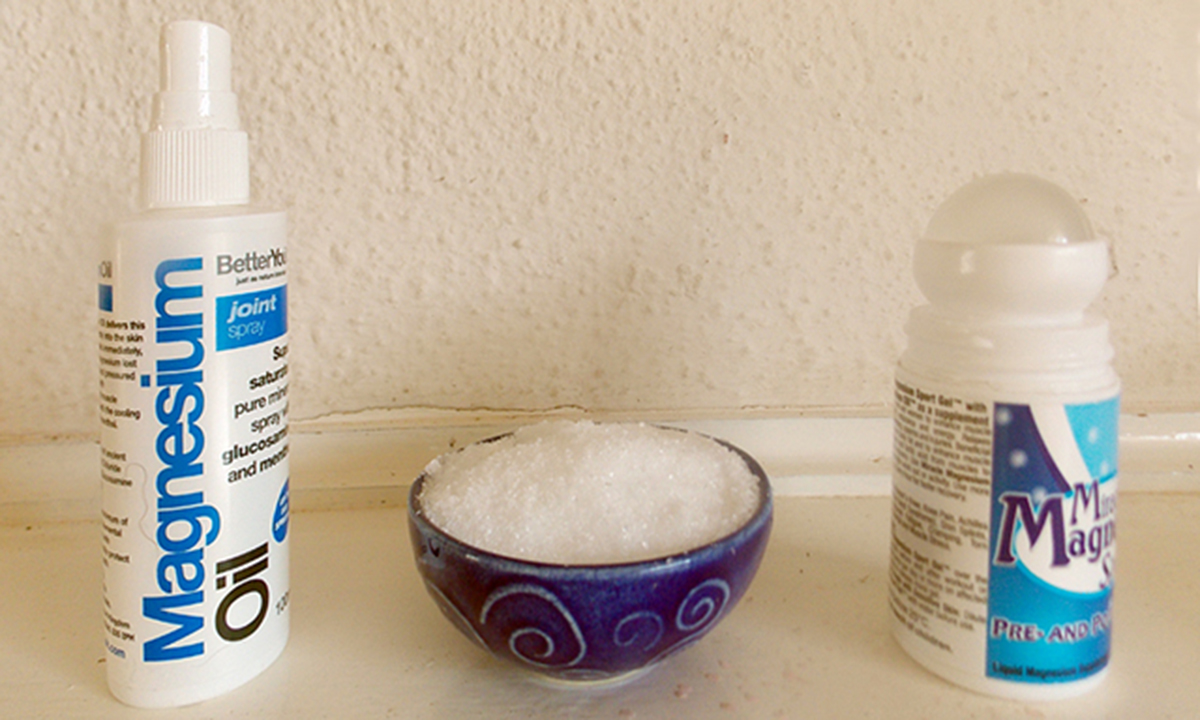Magnesium has been lauded as a miracle mineral for longer than most people realize, certainly from the beginning of the 19th century. Some say it has been used for its therapeutic benefits for much longer, probably more than 2,000 years. But even though there has been considerable scientific research regarding its benefits, magnesium in general remains a controversial topic in terms of efficacy.
Many people who have used it, and taken it orally in various forms, swear by it, probably because there are so many conditions that may be triggered by a deficiency in magnesium – many of which are life threatening. With too little magnesium, there are increased risks of getting asthma, bowel disease, cystitis, diabetes, heart disease, hypertension, hypoglycemia, kidney and liver diseases, osteoporosis, and Raynaud’s Syndrome.

Deficiency can also lead to some relatively basic health issues that can be reversed by boosting ones magnesium intake. These include tooth decay, migraines, fatigue and insomnia. Further, sufficient magnesium in the body generally keep the adrenal stress hormones controlled and in this way prevents panic and anxiety attacks. It also helps prevent depression because serotonin, which elevates mood, depends on magnesium.
So what is magnesium and what can it do for us? Commentary is provided by individual doctors and researchers as well as by US government health agencies (including the National Institutes of Health, the NIH). The challenge is to unravel the differences between scientifically proven efficacy and claims made by unscrupulous manufacturers, as well as to differentiate between the effects of too little magnesium (as discussed above) and the mineral’s accepted healing properties.
About Magnesium And Its Healing Properties
Magnesium is an element that occurs naturally in both sea and ground water, and rocks, as well as in all plants and animals. It ranks fifth on the list of the most common minerals found in the earth’s crust.
As stated on the NIH MedlinePlus website, magnesium is important for more than 300 chemical reactions that our bodies rely on to work properly. These include the growth and maintenance of the bones in our skeleton; the function of muscles and nerves; and the way our intestines and stomach work.
The NIH Natural Medicines comprehensive Database rates the effectiveness of magnesium in general, based on scientific evidence, and shows that:
- It is proven to be effective as a laxative for constipation; dyspepsia (heartburn); high blood pressure, specifically during pregnancy; and of course to treat and prevent magnesium deficiency, particularly for those who have heart failure, liver disorders or kidney dysfunction, diarrhea or vomiting.
- It is very likely to be effective for irregular heartbeat (torsades de pointes).
- It may possibly be effective for a huge number of other diseases and illnesses including asthma, cerebral palsy, chronic fatigue syndrome (now known as Systemic Exertion Intolerance Disease, SEID), fibromyalgia, and stroke.
- It is “possibly ineffective” for heart attack, stillbirths, tetanus, traumatic brain injury, and two others that many claim it does seem to help: athletic performance and muscle cramps. This of course adds to the controversy.
Probably the best-known source of magnesium in the modern world, Epsom Salts originated in the town of Epsom in Surrey, England in the 18th century. The story is that a farmer whose cows refused to drink the bitter-tasting well water he fed them discovered it healed small cuts and rashes. Much later, scientists discovered the key ingredient in the water (or salt extracted from the water) was magnesium sulphate.
According to Australian author and medical doctor, Sandra Cabot, who has written several titles about magnesium being a miracle mineral, it can be “life saving” as it reduces risk of sudden death that so often results from various cardiac catastrophes. She says it can also help people who suffer from a wide range of health and medical issues including, in alphabetical order: angina, arthritis, asthma, constipation, depression and anxiety, diabetes, facial and eye twitching, fibromyalgia, heart disease, high blood pressure, migraine headaches, muscle cramps, muscle tightness, poor circulation, poor sleep, SEID, and stress. She also maintains it can give athletes “the winning edge.”
READ Magnesium Deficiency: A Silent Epidemic?
As Cabot and other experts point out over and over again, the best way to ensure we get enough magnesium is to stick to a healthy diet that includes magnesium-rich dark-leafy vegetables, legumes and grains (see examples above, from left to right clockwise: avocados, kale, bananas, spinach or Swiss chard, broccolli, nuts.)
What Forms Of Magnesium To Use
It’s really a no-brainer if you know anything about nutritional and health supplements, but as Dr Cabot points out, the various supplements that contain magnesium also contain other substances, and the amount of magnesium varies, sometimes dramatically. As an example, she says magnesium oxide contains 60 percent magnesium, while magnesium carbonate contains 45 percent, and magnesium ascorbate only six percent (with a whole lot of other options inbetween.)
If you buy a product that contains 500 mg of magnesium glycinate, your will only get 50 mg of magnesium.
Another medical doctor who has written much about the miracle healing properties of magnesium is American Dr Carolyn Dean who, like Cabot, focuses not only on how magnesium can help, but also how drastic the effects of magnesium deficiency can be. She points out that magnesium oxide, which is the least expensive of all forms, is only four percent absorbed, the balance going through the intestines.

She points out that magnesium citrate is the form most commonly used, and lists several others that are often included in medication due to the fact they have a less laxative effect on the body. Generally, she says, magnesium oil, which as mentioned earlier is a generically controversial product, is normally made with just more than a third magnesium chloride and balanced with trace minerals and sea water. It does not contain oil.
Dr Dean uses several different types of magnesium, including magnesium oil, though she doesn’t state which particular product, and there is no doubt that they vary in terms of quality. She prefers the oil, because when she takes magnesium “by mouth,” she tends to have “a laxative reaction.” But she warns that it is essential to read the labels on products, and to understand what you are reading.
Personal Experience Using Magnesium
My own awareness of “miracle magnesium” started quite recently when I entered a 10 km run/walk competition and we were given a South African produced magnesium sports gel freebie after finishing (picture, top right). Supplied in a similar form to roll-on deodorant, the label indicated it was primarily sold to help prevent cramping, muscle spasms, and to remove toxins and promote recovery of muscles after exercise. But the advertising pamphlets claimed it could be used to treat just about everything from mental stress to period pains.
Then I tried it, and it definitely helped to ease muscle pain after long-distance aerobic walking. I spoke to other walkers and runners and found that many of them used this very product, particularly to counter cramping. I subsequently discovered another UK-produced magnesium oil that also contains glucosamine and menthol and is manufactured to be sprayed onto joints (picture, left). This I find to be even more effective, though it is clearly personal preference.
At about the same time I realized that Epsom Salts – in itself a miracle product – is magnesium sulphate (picture, center). Dissolved in warm water, it is promoted as a product that will draw toxins from the body, reduce swelling, relax muscles, and sedate the nervous system. It is also a great skin exfoliator and is excellent for drawing splinters and soothing insect bites. Growing up in the hot African sun, I have used it for decades to relieve the effects of sunburn, without realizing it is a form of magnesium. Since I started walking competitively two years ago, I often soak in a hot bath with Epsom Salts after major exertion, and find it does wonders for my muscles.
READ Magnesium for Weight Loss: Does It Really Work?
At the end of the day, it’s important to recognize the general unwillingness of many medical and clinical practitioners to acknowledge the need for nutrient supplementation in our diet. To quote Dr Dean: “It all stems back to a medical education that is funded by drug companies that have no vested interest in promoting nutrients” that cannot be patented and don’t cost much.
- www.nlm.nih.gov/medlineplus/druginfo/natural/998.html
- ods.od.nih.gov/factsheets/Magnesium-HealthProfessional/
- drcarolyndean.com/magnesium_miracle/
- www.needs.com/product/HWC08-MAG-01/l_Magnesium
- MAGNESIUM The Miracle Mineral “You won’t believe the DIFFERENCE it makes to your HEALTH and your SEX LIFE!” by Dr Sandra Cabot.
- Magnesium by Dr Sandra Cabot. Active Interest Media, Inc., California 2011 [free ebook from
- www.nutritionalmagnesium.org/listmessenger/public/Magnesium_ebook.pdf]
- Photos © Penny Swift
- Important notification about information and brand names http://www.steadyhealth.com/polices/terms-of-use#copyright


Your thoughts on this